- Relative Location
- Landscape and Physical Environment
- Weather and Climate
- Population, Density and Age/Sex Characteristics
- Language and Religion
- Cultural/Ethnic Groups
- Major Economic Activities
- Imports and Exports
- GNP and GNP Per Capita
Physical Characteristics
Mexico is considered to be a part of Middle America with countries Guatemala, Belize, Honduras, Nicaragua, El Salvador, Costa Rica, and Panama to its South and the United States of America to its North. Eastern Mexico is bordered by the Gulf of Mexico and to the West the Pacific Ocean and Gulfo de California. The size of Mexico makes this nation the 13th largest country on the planet covering 770,00sq mi (Wikipedia). This nation is comprised of 31 states and Mexico City, the nations capital. Mexico is often described as being physically similar to that of the American Southwest with sprawling deserts, flora and fauna,and mountain ranges/valleys. Mexico most notably is crossed with several different mountain ranges: Sierra Madre Oriental and the Sierra Madre occidental that are extensions of the Rocky Mountains of North America, the Trans-Mexican Volcanic Belt of the Sierra Nevada, and Sierra Madre del Sur (Wikipedia/Goode's World Atlas). Three major urban settlments are situated in the valleys between these ranges: Toluca, Mexico City, and Puebla.
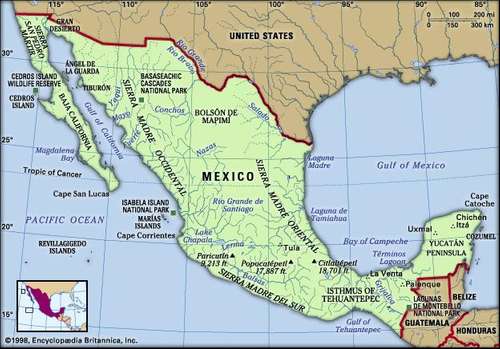
The climate of Mexico is determined by the Tropic of Cancer which divides the nation into two zones: tropical and temperate. Land North of the 24th parallel experiences coolor temperatures in the winter months while areas South of the 24th parallel enjoy temperatures that remain fairly constant year-round and vary solely by elevation (Wikipedia); because of this climate separation, Mexico has one of the most unique and diverse weather systems. Northern Mexico is considered a semi-arid climate with sporadic rainfall while the Yucatan Peninsula boasts a tropical/rainforest climate with rainy season from June to October, and Coastal Mexico on the East and West can experience Hurricanes during the summer and fall.
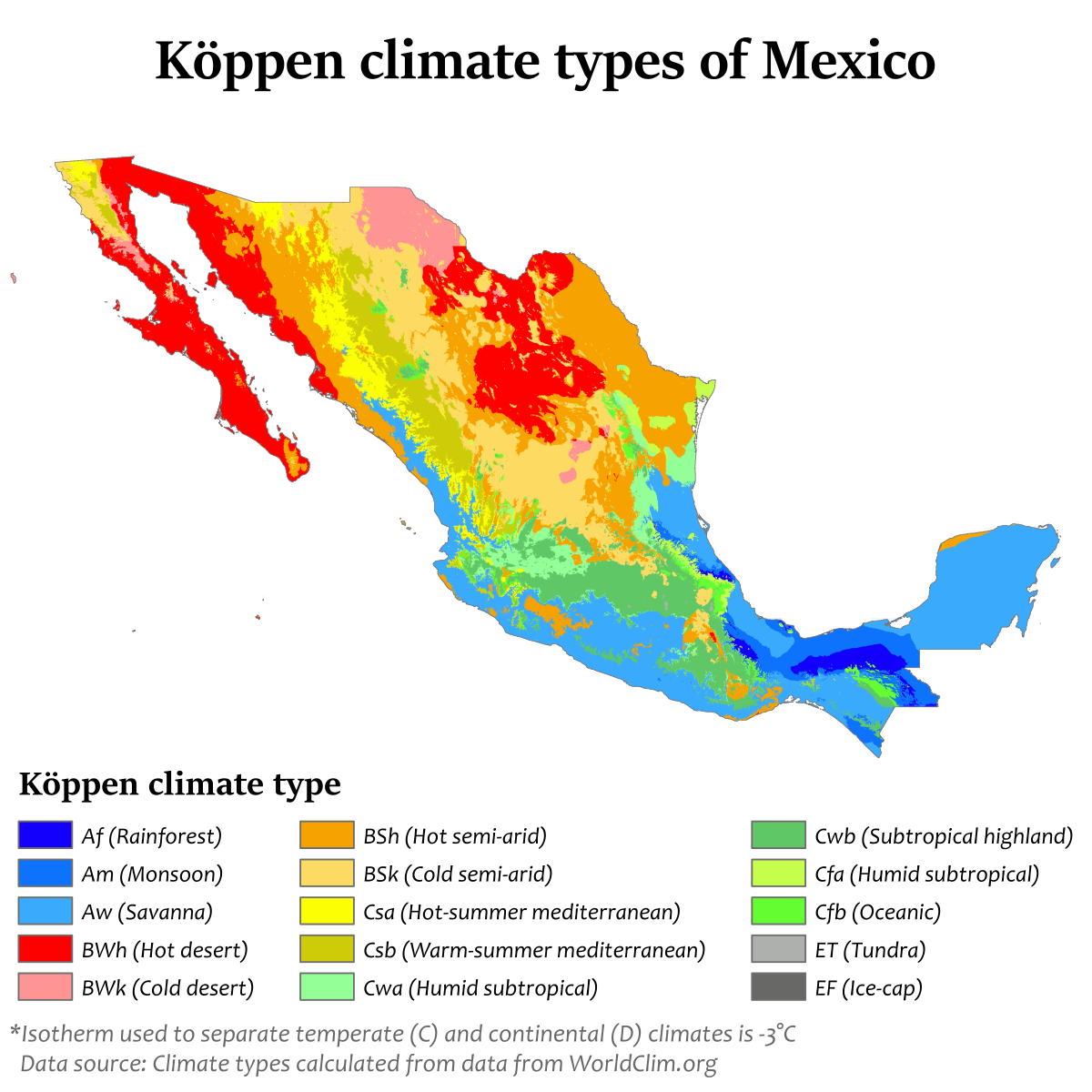
Human Characteristics
Mexico is the 10th most populus country in the world with a total population of 126.6 million people (Population Reference Bureau) and the most populus Spanish-speaking country in the world (Wikipedia). Mexico City, the nations capital, is the Western Hemispheres second most populus city and North Americas most populated city with a total population of 8.855 million residents (World Atlas) with the surrounding suburbs totaling the population to 21.5 million residents. Nearly half of the Mexican population lives in some sort of classified poverty while the wealthy of Mexico continue to gain riches, this has shown to remain relatively unchanged overtime. The ongoing Drug War in Mexico between the government and drug traffickers has killed more than 100,000 people; the source of this gross number comes from the amount of wealth obtained by selling of illegal drugs, with $60 billion worth being sold to Americans. (Finlayson, 2016)

This image shows a population pyramid that splits the male and female sexes and shows their distribution among specific age groups. As you can see, more than half of the Mexican population is under the age of 45 years old with the vast majority between age groups 0 months to 30 years of age. You can also see that Mexicos aging population is very small which coincides with their average life expectancy of 75 years (72 males/78females) (Population Reference Bureau).
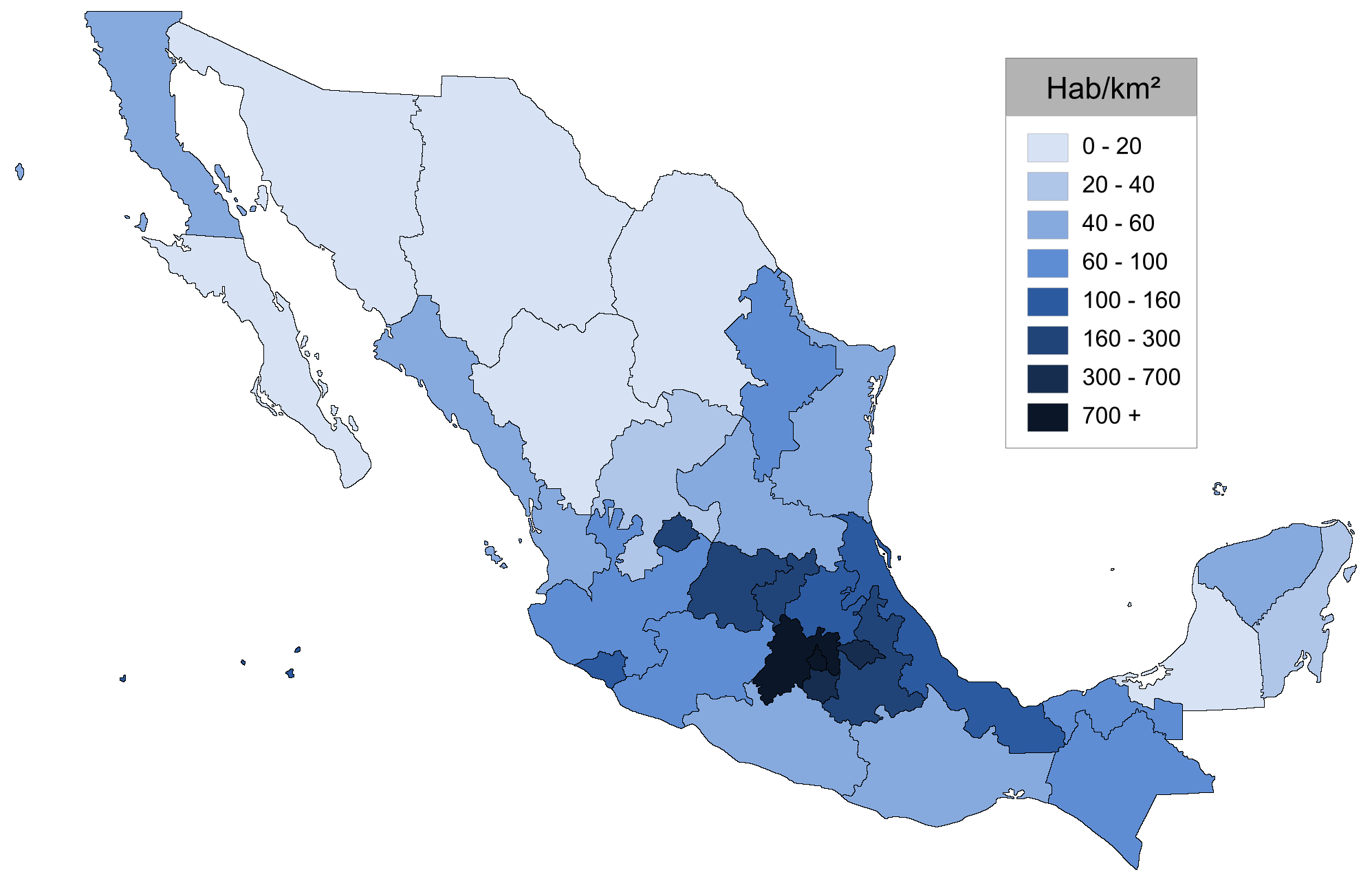
This image shows the population density across Mexico with the highest concentration located around the capital, Mexico City; the surrounding states of Cuernavaca and Toluca are also a part of this high population density of 700+ habitants/sq kilometers.
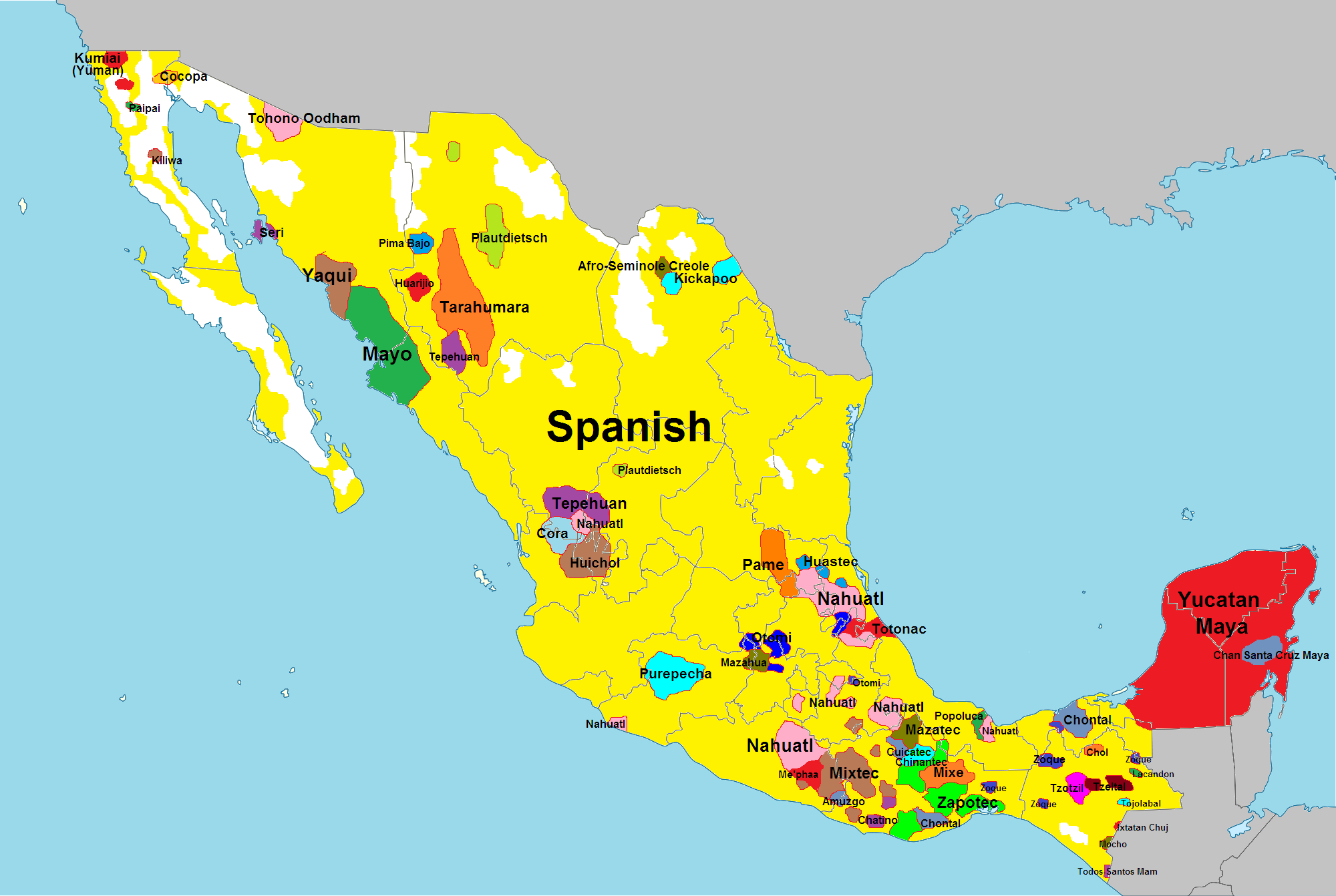
This image shows the various languages spoken throughout Mexico; Mexico does not have an official language but does recognize regional languages including, Spanish and 68 Amerindian languages (Wikipedia).
According to a census done in 2010, 87% of the population identified as Catholic, 7% Protestant, 5% irreligious, 1.5% Jehovah's Witnesses, 2% other religions, and 3% as unspecified (Wikipedia). The religious census results coincide with historical aspects of the nation with the colonial occupation by Spain for centuries that transitioned the natives of the area of which practiced their own religions to Catholisism. Although Mexico is considered to be a highly diverse nation, all inhabitants are under the same identity of 'Mexican', which was promoted after the revolution in the early 1900s to create a racially and culturally homogeneous country (Wikipedia). The majority of Mexicos indigenous population lives within the Southern and Southeastern Mexican states of: Yucatan, Quintana Roo, Campeche, Oaxaca, Chiapas, Hidalgo, Puebla, Guerrero, San Luis Potosi, and Veracruz. Mexicos Northern and Western regions have the highest concentrations of European populations that do not have any native mixture or predominat European ancestry (Wikipedia).
Economic Characteristics

MEXICO ECONOMY - This link will take you to the OEC interactive data tree on the Mexican Economy and details the individual sources of imports/exports and the amount of income received.
Mexicos economy is considered to be the 15th largest nominal GDP with an annual average growth of approximately 2% in 2017 and 11th largest PPP. Agriculture only makes up 4% of their economy while industry contributes 33% (automotive, oil, and electronics). However, the largest proponent of the Mexican economy comes from financial services and tourism contributing a whopping 63%. Places like Cancun, Playa del Carmen, and historical Aztec and Mayan ruins are popular destinations for tourists. Top exports for the country include: Cars, vehicle parts, delivery trucks, computers, and crude petroleum. Top imports for the country include: vehicle parts, refined petroleum, cars, computers, and petroleum gas. When looking at export destinations (tourism), the top nations contributing to this are: United States, China, Germany, and Japan (Ortega).
Mexicos GNP was reported at 1.1 billion USD in December of 2018 which was an increase from the numbers of the previous years. The GNP per capita was valued at 9,180. These values have fluctuated over the course of 60 years.
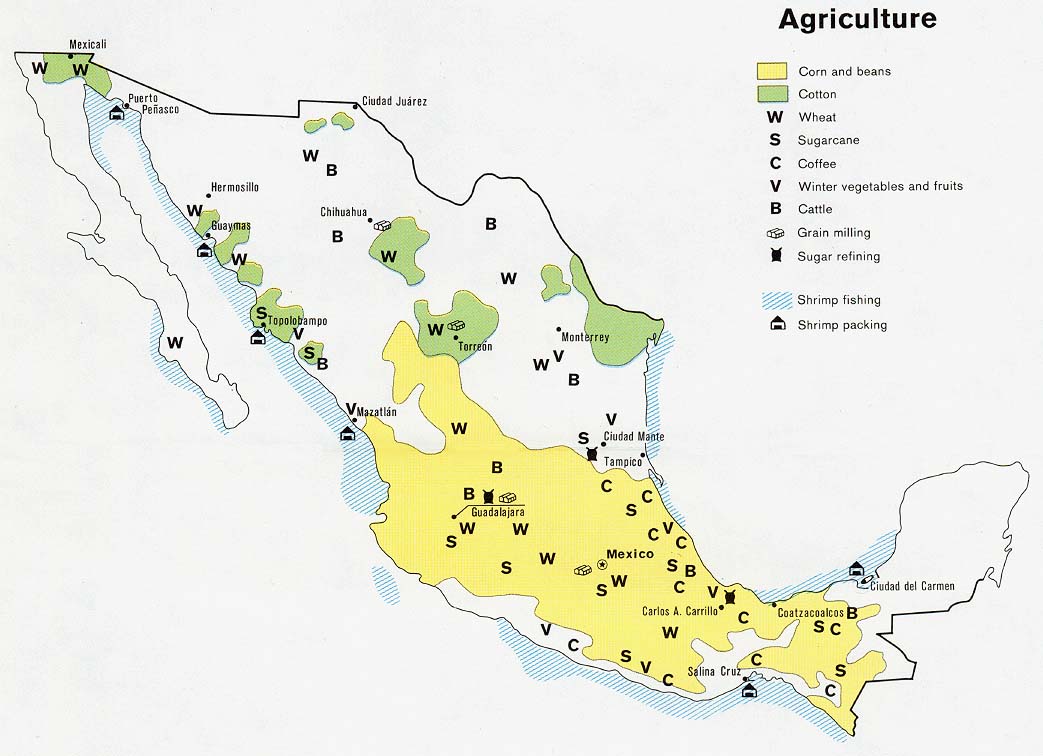
This image above details the various types of agriculture found within Mexico. We can see a large portion of Middle and Southern Mexico farms both corn and beans with pockets of cotton production in the Northern part of the country, and the coastal areas of Mexico contributing to the shrimping industry.
References
Finlayson, Caitlin. 'World Regional Geography.' University of Mary Washington, 2016. http://caitiefinlayson.com/WRGTextbook.pdf.
“Mexico - GNI per Capita.” Mexico - GNI per capita. Accessed April 27, 2020. https://www.indexmundi.com/facts/mexico/gni-per-capita.
'Mexico.' Wikipedia. Wikimedia Foundation, April 17, 2020. https://en.wikipedia.org/wiki/Mexico.
Ortega, Carlos. 'Mexico.' OEC. Accessed April 17, 2020. https://oec.world/en/profile/country/mex/.
Sawe, Benjamin Elisha. 'The 10 Largest Cities in the World.' WorldAtlas. WorldAtlas, September 27, 2017. https://www.worldatlas.com/articles/the-10-largest-cities-in-the-world.html.
Sutton, Christopher J., ed. Goode's World Atlas. 23rd ed. Rand McNally, 2017.
Submitted by Katie Holderfield on 4/17/2020